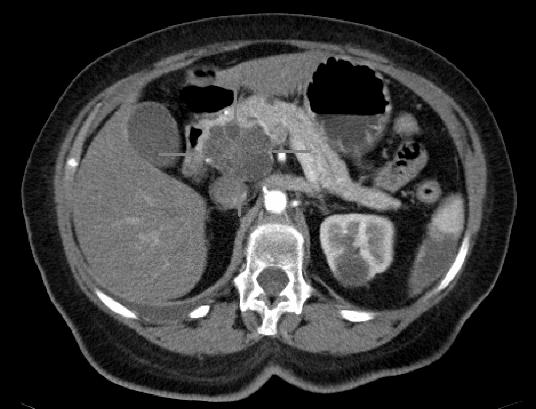Axial CT image with iv contrast. Macrocystic adenocarcinoma of the pancreatic head. Author: public domain
Research presented today at UEG Week 2022 has shown that pancreatic cancer tumors are being missed by CT scans and MRIs, narrowing the window for life-saving surgery.
The study analyzed cases of post-imaging pancreatic cancer (PIPC), where a patient undergoes imaging that does not diagnose pancreatic cancer but is later diagnosed with the disease. The results showed that more than a third (36%) of PIPC cases were potentially avoidable, demonstrating an alarmingly low rate of cancer detection outcomes for patients.
British researchers studied the records of 600 patients diagnosed with pancreatic cancer between 2016 and 2021. Of these, 46 (7.7%) patients could not be diagnosed with cancer at the first scan, but were subsequently diagnosed with pancreatic cancer between 3 and 18 months later. .
CT and MRI images were independently reviewed by radiologists to develop an algorithm to classify missed cases and determine the most likely explanation for why they were missed.
Dr Noshin Umar, lead author of the study from the University of Birmingham, UK, commented: “There is often a very short window to curative surgery for pancreatic cancer, meaning it is vital that patients are diagnosed with the disease as early as possible to give them better chance of survival. The study found that signs of pancreatic cancer were initially missed in more than a third of pancreatic cancer patients after imaging, which is a huge window of missed opportunities.”
Almost half (48%) of PIPC patients screened had signs of cancer that were missed when scanned by a specialist hepatobiliary radiologist. In 28% of patients with PIPC, imaging features associated with pancreatic cancer, such as bile or pancreatic ductal dilatation, were not recognized and investigated further.
“We hope this study will raise awareness of the problem of pancreatic cancer after imaging and the common reasons why pancreatic cancer may be missed initially,” explained Dr. Umar. “This will help standardize future research into this problem and direct quality improvement efforts so that we can increase the likelihood of early pancreatic cancer diagnosis, improve patient survival and ultimately save lives.”
Pancreatic cancer, responsible for 95,000 deaths in the EU each year, has the lowest survival rate of any cancer in Europe, with a life expectancy at diagnosis of just 4.6 months. By 2035, the number of cases pancreatic cancer an increase of almost 40% is predicted.
Many patients are diagnosed at a late stage because the early symptoms of the disease are often vague, making early recognition difficult. Symptoms may include jaundice, abdominal and back pain, unexplained weight loss, and nausea. The complex nature of the disease also makes screening for early diagnosis difficult.
Courtesy of United European Gastroenterology
Citation: Study Reveals Alarming Failures in Pancreatic Cancer Detection (2022, October 10) Retrieved October 10, 2022, from https://medicalxpress.com/news/2022-10-reveals-alarming-failures-pancreatic-cancer.html
This document is subject to copyright. Except in good faith for the purpose of private study or research, no part may be reproduced without written permission. The content is provided for informational purposes only.






